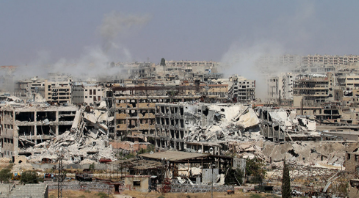Aleppo: The Terror of the Syrian Civil War

January 11, 2017
As bombs plunge to the earth and bullets whiz, a city is left devastated. Innocent men, women, and children witness their homes buried in rubble. A life of agony and despair replaces their previous existence in a thriving city. For the past several years, Syria has been torn apart by a bloody civil war. The conflict, between a Russian-backed government, a US-backed rebel group, and ISIS, has resulted in a major humanitarian crisis. Millions of refugees have fled the country to avoid utter devastation. However, the citizens of Aleppo, the country’s most populous city, have not been so lucky. As the conflict ensues in the heart of the city, residents live trapped in a warzone, with no ability to flee. In a battle that has threatened the lives of hundreds of thousands, Aleppo has emerged as the single most pressing humanitarian crisis the world has witnessed in years.
The war has its roots in the Arab
Spring of 2011, where the peoples of the Middle East began to protest oppressive regimes, calling for democracy. For Syrians, this became a protest against the Syrian dictator, President Bashar al-Assad. Their cries for change saw little success, as Assad violently repressed the efforts.
In March of 2011, government forces open fired on activists, resulting in four deaths, and a loud statement on the part of the Assad regime.
On July 29th 2011, seven officers from the Syrian army defected and formed the Free Syrian Army, thus beginning the first period of conflict.
That October, this period ended with official support of the rebels coming from Turkey.
The conflict escalated the next month, continuing on steadily until the first ceasefire in March. Yet this glimmer of peace lasted only briefly, with conflict soon heating up once more.
Then, in October 2012 the rebels took eastern Aleppo, a strategic city in northwest Syria. The fighting persisted throughout 2013 with little gain on either side. However, in 2014, the government encircled Aleppo, and the long siege began. The war was now one of attrition.
For the Assad government, the siege of Aleppo has meant concentrating rebels where they can be bombarded effectively in order to recapture the city. For the rebels, it means a tough road ahead, with airstrikes causing massive destruction on a daily basis. Currently, Assad’s government boasts a rather clear victory, gaining much of previously held rebel territory. Yet for the citizens, this victory suggests that thousands of casualties could follow. Although some evacuation efforts, like the UN’s goal to resume exits for children trapped in the city, have been put forth, civilians will ultimately be held vulnerable in a conflict they lack control over. As battle tears their city apart, these civilians face their mortality head on, without peace or any glimpse of hope. Destruction has become their reality in the Battle of Aleppo.
Under this immense humanitarian crisis, some have valiantly carried the torch of heroism. The members of the Syrian Civil Defense, known better by their nickname the “White Helmets”, have aided in protecting Syrian civilians. In treating the injured, saving abandoned Syrian people, and working as outlets for crisis response, a force of approximately 3,000 volunteers contribute greatly to the humanitarian efforts the civilians desperately require. While they are unarmed, the volunteers provide resistance against government abuse through their emphasis on the innocent people of Syria. The “White Helmets” in Aleppo demonstrate to the world that their duty of rescuing those left in the dust is a response to oppression by a Syrian regime.
Syria’s war has certainly induced suffering for all parties involved. The Free Syrian Army is now only one of several loosely allied factions, many of which are radical islamists. Nonetheless, the US, Turkey, France, Qatar, Jordan and Saudi Arabia have been backing the opposition . Meanwhile Russia, Iran, Iraq, and China have taken Assad’s side. The conflict in Syria has become a “proxy war”, where regional and global powers clash indirectly, such as the Vietnam War, and the Korean War in the 20th century. Which were indirect clashes between US and the USSR. With the fall of Aleppo and the turning tide, the outcome seems grim for the West. Russia’s backing of the Assad regime complicates the United States’ role in the conflict.
Although in support of the Assad opposition, the US has been unable to engage directly, and “save Aleppo” as this would have resulted in a direct conflict with Russia, posing the threat of a new world war or nuclear catastrophe. Their ability to provide assistance also has been limited due to the questions that rise in dealing with the radical factions that make up the rebellion. The idea of providing arms or aid to a group the United States cannot fully trust poses controversy or potential risk in the future. With a desperate crisis needing attention, the U.S. has been left unable to act without consequence.
After nearly 6 years of bloody fighting, the regime holds a convincing edge against scrambling rebel factions. Despite this,Assad notably lacks the manpower to hold his gains against both rebel groups and ISIS. However with continued Russian support, his ability to maintain control in Syria’s unpredictable landscape may indeed remain. As a result of the imminent danger posed in Syria, waves of desperate refugees continue to flood both Europe as well as other parts of the world. . The war carries on, threatening the lives of many, and putting into question international geopolitics as a whole.






